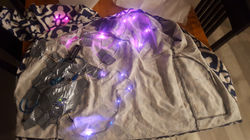Fashion Technology
Group Members: Tyler Cooper, Neil Chulpongsatorn, Jordan Lee
For this project our team was to create a fashion tech garment with Arduino. The input and output sensors would be integrated into some kind of clothing to look like a functional, aesthetic product. We must have at least one output and input device, and all wires and boards must be hidden by the clothing. Furthermore, the piece has to have an interesting concept and story behind it.
10 Design Sketches
My Initial Ideas
(Hover/click over sketches for more info)
My personal favourites are the bee outfit and tentacle accessory inspired by climate change. I also like the light up aprons.
Deciding on the Wearable
The Story Behind the Kimono
After discussing all our favourite sketches, we decided to go with Neil's kimono idea because of its story and it's realistically doable compared to other ideas such as the tentacles and networking web pieces, etc.
The story of the kimono as a fashion technology:
Neil grew up partly in Thailand, which is a beautiful country. In Thailand and some other Asian countries, they have festivals during the summer where people would wear kimonos and fireworks would be fired up in the sky in the night.
The kimono idea is inspired by bringing that same festival feel and vibe in any location, by emulating a fireworks light-show on the kimono itself.

10 Refined Sketches
Group favourite ideas that helped with the final design
(Hover/click over sketches for more info)
The group expanded on the networking wearable idea where your network (displayed as LED lights) will expand the more people you shake hands with, as well as the kimono idea where it captures the feeling of being in an Asian summer festival.
Sensors & Output
The two input sensors we have are:
Light sensor: to detect if it's dark. We want the kimono to light up only when it's dark because that is the type of setting we want to capture (nighttime summer festival), plus the lights show up better during the night.
Temperature sensor: to detect if it is warm. We want it to be warm again because this type of temperature captures the nighttime summer festival mood.
The output are the LED lights which are designed in a pattern to represent fireworks.


Limitations & Challenges
No sewing: Since the kimono we have is authentic, expensive, and holds value to the owner (Neil), he requested no sewing and only use tapes to attach the boards and wires to the clothing. The main challenge with this was that the tapes will make the inside of the kimono look and feel bulky, however the inside won't be shown when worn, so it worked out in the end.
Temperature activation: Sometimes it might take a little bit of rubbing, blowing, or putting the sensor beside something hot to activate the lights. We didn't want the lights to activate just by casually being in a room with room temperature.
Light Diffusion Vest
We made a light diffusion vest made of foam and plastic to help diffuse and maximize the look of the LED lights. The vest is worn underneath the kimono.
 |  |  |
|---|



















